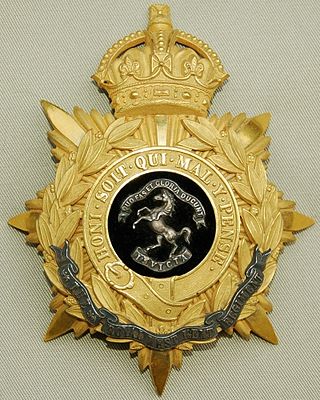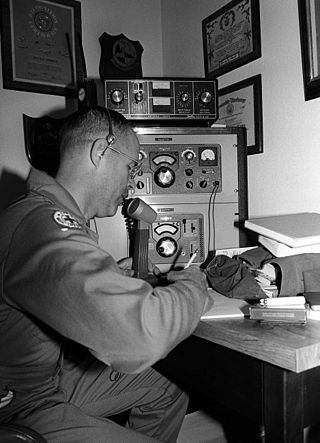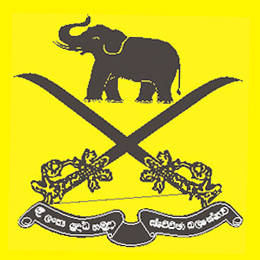External links
- 36th New York Volunteer Infantry- a site designed and researched by descendants of soldiers serving in this regiment, contains an unofficial history
- The New York British Volunteers
The New York British Volunteers was a short-lived regiment in the Union Army during the American Civil War. The unit began recruiting in New York City shortly after the outbreak of the war, and managed to draw several hundred recruits. The regiment was staffed by former members of the British Army, many of whom were veterans of the Crimean War. In a hurry to field as many units as possible, the State of New York transferred the men of the New York British Volunteers to another understrength regiment, the Washington Volunteers. This new formation was designated the 36th New York Infantry. A number of the former officers of New York British Volunteers subsequently resigned, while a number of the rank and file are reported to have deserted.

A regiment is a military unit. Its role and size varies markedly, depending on the country, service, or specialisation.

United States Colored Troops (USCT) were Union Army regiments during the American Civil War that primarily comprised African Americans, with soldiers from other ethnic groups also serving in USCT units. Established in response to a demand for more units from Union Army commanders, USCT regiments, which numbered 175 in total by the end of the war in 1865, constituted about one-tenth of the manpower of the army, according to historian Kelly Mezurek, author of For Their Own Cause: The 27th United States Colored Troops. "They served in infantry, artillery, and cavalry." Approximately 20 percent of USCT soldiers were killed in action or died of disease and other causes, a rate about 35 percent higher than that of white Union troops. Numerous USCT soldiers fought with distinction, with 16 receiving the Medal of Honor. The USCT regiments were precursors to the Buffalo Soldier units which fought in the American Indian Wars.

The Army Reserve is the active-duty volunteer reserve force of the British Army. It is separate from the Regular Reserve whose members are ex-Regular personnel who retain a statutory liability for service. The Army Reserve was known as the Territorial Force from 1908 to 1921, the Territorial Army (TA) from 1921 to 1967, the Territorial and Army Volunteer Reserve (TAVR) from 1967 to 1979, and again the Territorial Army (TA) from 1979 to 2014.

Yeomanry is a designation used by a number of units and sub-units in the British Army Reserve which are descended from volunteer cavalry regiments that now serve in a variety of different roles.

The New Army, often referred to as Kitchener's Army or, disparagingly, as Kitchener's Mob, was an (initially) all-volunteer portion of the British Army formed in the United Kingdom from 1914 onwards following the outbreak of hostilities in the First World War in late July 1914. It originated on the recommendation of Herbert Kitchener, then the Secretary of State for War to obtain 500,000 volunteers for the Army. Kitchener's original intention was that these men would be formed into units that would be ready to be put into action in mid-1916, but circumstances dictated the use of these troops before then. The first use in a major action of Kitchener's Army units came at the Battle of Loos.
The Irish Brigade was an infantry brigade, consisting predominantly of Irish Americans, who served in the Union Army in the American Civil War. The designation of the first regiment in the brigade, the 69th New York Infantry, or the "Fighting 69th," continued in later wars. The Irish Brigade was known in part for its famous war cry, the "Faugh a Ballaugh" which is an anglicization of the Irish phrase, fág an bealach, meaning "clear the way" and used in various Irish-majority military units founded due to the Irish diaspora. According to Fox's Regimental Losses, of all Union army brigades, only the 1st Vermont Brigade and Iron Brigade suffered more combat dead than the Irish Brigade during America's Civil War.

The Queen's Own Royal West Kent Regiment was a line infantry regiment of the British Army based in the county of Kent in existence from 1881 to 1961. The regiment was created on 1 July 1881 as part of the Childers Reforms, originally as the Queen's Own (Royal West Kent Regiment), by the amalgamation of the 50th (Queen's Own) Regiment of Foot and the 97th (The Earl of Ulster's) Regiment of Foot. In January 1921, the regiment was renamed the Royal West Kent Regiment (Queen's Own) and, in April of the same year, was again renamed, this time as the Queen's Own Royal West Kent Regiment.

Auxiliaries are support personnel that assist the military or police but are organised differently from regular forces. Auxiliary may be military volunteers undertaking support functions or performing certain duties such as garrison troops, usually on a part-time basis. Unlike a military reserve force, an auxiliary force does not necessarily have the same degree of training or ranking structure as regular soldiers, and it may or may not be integrated into a fighting force. Some auxiliaries, however, are militias composed of former active duty military personnel and actually have better training and combat experience than their regular counterparts.

The Regular Army of the United States succeeded the Continental Army as the country's permanent, professional land-based military force. In modern times, the professional core of the United States Army continues to be called the Regular Army. From the time of the American Revolution until after the Spanish–American War, state militias and volunteer regiments organized by the states supported the smaller Regular Army of the United States. These volunteer regiments came to be called United States Volunteers (USV) in contrast to the Regular United States Army (USA). During the American Civil War, about 97 percent of the Union Army was United States Volunteers.

A rifleman is an infantry soldier armed with a rifled long gun. Although the rifleman role had its origin with 16th century hand cannoneers and 17th century musketeers, the term originated in the 18th century with the introduction of the rifled musket. By the mid-19th century, entire regiments of riflemen were formed and became the mainstay of all standard infantry, and rifleman became a generic term for any common infantryman.

A Scottish regiment is any regiment that at some time in its history has or had a name that referred to Scotland or some part thereof, and adopted items of Scottish dress. These regiments were created after the Acts of Union in 1707 between England and Scotland, either directly serving Britain during its various wars, or as part of the military establishments of Commonwealth countries. Their "Scottishness" is no longer necessarily due to recruitment in Scotland nor any proportion of members of Scottish ancestry.
The 36th Ohio Infantry Regiment was an infantry regiment that served in the Union Army during the American Civil War. Recruited from several counties in southeastern Ohio, the regiment participated in several battles in the Eastern Theater before being transferred for a period to the Western Theater. In 1864, it returned to the East and participated in the Valley Campaigns of 1864.
The 36th New York Infantry Regiment was a New York Civil War regiment. It was a unique fighting force, including both Irishmen and New York Britons, having absorbed the New York British Volunteers while organizing. A colorful group known for its antics and in-fighting, it nevertheless made important contributions to the Union cause at such battles as Seven Pines, Malvern Hill, Fredericksburg, and Chancellorsville. Many of its members were also present during the New York Draft Riots.
The 29th Ohio Infantry Regiment was a volunteer infantry regiment in the Union Army during the American Civil War. Raised in the northeastern part of the state of Ohio, the 29th served with distinction in several battles of the Atlanta Campaign.

The Sri Lanka Army Volunteer Force (SLAVF) is the active-duty volunteer reserve force of the Sri Lanka Army. The SLAVF is separate from the Regular Force which consists of personal who are professional soldiers and its Regular Reserve, which comprises personal who have a mobilization obligation following their service in the regular army. The SLAVF consists of the volunteer force and the volunteer reserve; administration and recruitment of reserve personal is carried out by the Volunteer Force Headquarters in Shalawa, Kosgama which is headed by the Commandant of the Volunteer Force. It has a current strength of about 55,000 personnel. The SLAVF was known as the Ceylon Volunteer Force from 1949 to 1972 and the Sri Lanka Volunteer Force from 1972 to 1985.
36th Regiment or 36th Infantry Regiment may refer to:
Alonzo Granville Draper was a volunteer officer in the Union Army during the American Civil War who eventually earned the grade of brevet brigadier general. During his early career, Draper was an outspoken advocate of various social causes, particularly worker's rights. As an officer during the Civil War, Draper was best known as the commander of the 36th United States Colored Troops.